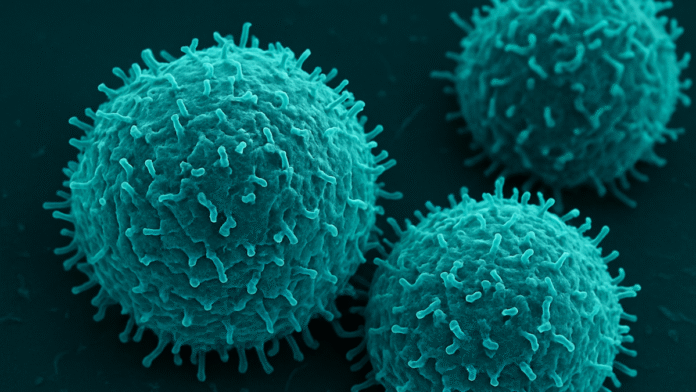Cancer immunotherapy, especially using T cells, is showing a lot of promise in treating blood cancers. Bioengineered T cells, especially those equipped with chimeric antigen receptors (CAR-T cells), have revolutionised cancer treatment.
But while they’ve delivered impressive results against certain blood cancers, they’ve struggled to make an impact in solid tumours, such as those in the breast, lung, and prostate.
A major problem is the tumour microenvironment (TME), which is a mix of cells and molecules that can dampen immune responses. In most solid tumours, inhibitory signals dominate while helpful ones (that tell T cells to keep going) are weak or entirely absent. Since engineered T cells rely on these environmental cues to stay active and functional, they often fall short. This has led scientists to explore ways of building extra receptors into the T cells, so they can pick up tumour-specific signals and respond with added strength.
Researchers have tried to create receptors that can sense and react to the TME, but designing them has been difficult because building custom signalling proteins is a complex endeavour. Meanwhile, most current methods for doing so rely heavily on trial-and-error, which eventually makes it hard to control how these synthetic receptors will eventually behave when deployed against a tumour.
Now, a team led by Patrick Barth at EPFL and Caroline Arber at UNIL-CHUV has developed a computational platform for designing synthetic protein receptors from scratch. These receptors, called T-SenSERs (tumour microenvironment-sensing switch receptors), are engineered to detect soluble signals found in tumours and convert them into co-stimulatory or cytokine-like signals that boost T cell activity. When combined with conventional CAR-T cells, the synthetic receptors enhanced their anti-tumour effects in models of lung cancer and multiple myeloma.
Their study was published in Nature Biomedical Engineering.
The computational platform can put together artificial receptors by designing and combining different protein domains, like building with molecular Legos. Each receptor includes an external domain that binds a tumour-associated signal, a middle region that transmits that signal across the cell membrane, and an internal domain that activates useful functions inside the T cell.
“What sets this approach apart from current protein design approaches is that it doesn’t treat proteins as rigid structures,” Barth said.
“Instead, it models them as dynamic, shape-shifting machines—allowing researchers to see, for the first time, how signals travel through these synthetic receptors to control cell behaviour.”
Using the platform, the team created two families of T-SenSERs: one that responds to VEGF, a protein that promotes blood vessel growth and is common in tumours, and another that responds to CSF1, a protein that negatively influences the behaviour of immune cells in tumours. They designed 18 versions and selected the best-performing ones based on simulations and lab tests.
When tested, T cells equipped with both a CAR and a T-SenSER responded more strongly to tumours than CAR-T cells alone and showed ligand-specific activities faithfully reflecting the signalling programmes encoded by the design method.
The VEGF-sensing version (called VMR) only activated the T cell when VEGF was present, while the CSF1-sensing version (CMR) provided a small baseline boost even without CSF1, but ramped up its effect in the presence of the ligand. In mouse models of lung cancer and myeloma, T cells with these synthetic receptors showed improved tumour control and longer survival.
The team found that their design method allowed them to fine-tune the receptors’ behaviour, choosing whether it should be always-on, ligand-dependent, or somewhere in between.
“This study represents the first demonstration of the computational design of single-pass, multi-domain receptors with programmable signaling functions and paves the way for the accelerated development of synthetic biosensors with custom-built sensing and response capabilities for basic and translational cell engineering applications,” says Barth.
Other contributors were the Ludwig Institute for Cancer Research, Baylor College of Medicine, Swiss Cancer Center Leman, and the AGORA Cancer Research Center.
Jim Cornall is editor of Deeptech Digest and publisher at Ayr Coastal Media. He is an award-winning writer, editor, photographer, broadcaster, designer and author. Contact Jim here.


